The world of coffee.
Main ways of preparing coffee.
There are various methods of preparing this drink, all based on the extraction of ground coffee substances with hot water. The various types of extraction refer to two general principles:
maceration - characterized by prolonged contact of coffee powder with water.
coffee with infusion; it is the simplest and most ancient method in the western world, it was first adopted in France in 1771. The water is boiled in a container, turned off, the coffee powder is poured and left to infuse for at least 5 minutes. Then it is poured into a jug or directly into the cups, filtering everything with a colander.
coffee with Melior system; it is a variant of the procedure described above and uses a piston infuser consisting of a pyrex jug and a metal mesh filter of the same diameter as the cylindrical jug, joined with a rod to the lid.
Pour boiling water and the coffee powder into the jug and leave to infuse for 5 minutes; then the filter is inserted and pushed towards the bottom of the carafe thus compressing the powder on the bottom. It is pleasant even lukewarm.
 Infusion coffee maker (Melior system)
Infusion coffee maker (Melior system)
Turkish coffee; widespread in the Balkan and Muslim countries. The water with the coffee powder and the sugar is boiled three times in a container (typical is the copper one). You can drink it with the powder in suspension or filter it, add a little cold water to facilitate the storage of the coffee
percolation - the water passes through the coffee and quickly drops into a container.
filter coffee; boiling water is poured over coarse ground coffee contained in a paper filter and passes through the powder by gravity. The preparation time is approximately 6-8 minutes. The drink contains almost no solid particles in suspension, the substances extracted from the water are about 16-18%. The drink has a low body, delicate taste and aromas. It is prepared in large quantities and stored in thermal containers, the quality depends on the time that passes between preparation and consumption.
Used in North America it takes 5-6 grams of light roasted coffee per cup; in the countries of Northern Europe and France the dose increases to about 10g. The volume in the cup is about 100-150 ml.
 Filter coffee machine
Filter coffee machine
coffee prepared with moka; the moka coffee maker is made up of three parts: the boiler at the bottom where the water is brought to a boil, the metal filter that contains the fine ground coffee in the middle and the tank that collects the drink at the top.
The water passes through the coffee thanks to the pressure provided by the steam of its boiling, the contact time is about one minute and extracts about 22% of the substances contained in the ground coffee. The taste is strong, with medium body and quite intense aroma. Normally about 6 gr are used. of roasted coffee per cup where the normal volume will be around 40-50 ml.
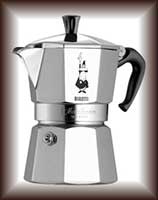 Moka coffee maker
Moka coffee maker
Neapolitan coffee; the coffee maker called "Neapolitan" uses the same principle of filter coffee, it is divided into two overlapping containers with a filter filled with coffee in the middle. The water is boiled and while it is boiling, the coffee maker is turned upside down so that the water as it falls passes through the filter containing the coffee, extracting the substances. Now not very common and replaced by mocha or espresso machines for domestic use.
espresso; the principle used is that of percolation but with a particular system of extraction of the substances that allows to obtain a very concentrated drink with intense taste and aromas. The extraction is performed with purified water at 90º-94ºC and at high pressure (about 9 Atm), the contact time between water and coffee varies from 15 to 35 seconds. Normally 6-7 gr are used. of coffee per cup, finely ground and medium to dark roasted. The volume of the drink in the cup ranges from 20 to 35 ml. (Italian).
The characteristics of an espresso coffee are:
the cream: it is a foam, that is a dispersion of gas (air and carbon dioxide) in a liquid; the liquid part involved in its formation contains oils emulsified in water.
the body; the body is due to the presence of oily emulsions that are formed in the presence of polar lipids (complex molecules capable of stabilizing the emulsions). The concentration of extracted substances is higher than in normal coffee (about 25%) and tiny particles of ground coffee are also present in suspension.
the aroma; the intensity is mainly due to the presence of the cream which avoids the dispersion of volatile substances immediately after the preparation of the drink.


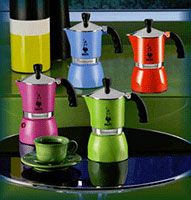
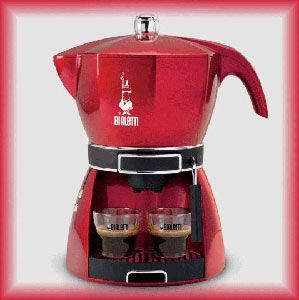
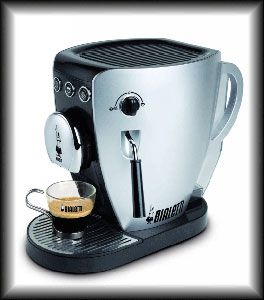
I cordially thank Industrie Bialetti for the kind concession of almost all the images on these pages. For more information visit the website http://www.bialetti.it

Regarding the professional espresso coffee machine, I will discuss a separate article.
Soluble and freeze-dried coffee; soluble coffee can be obtained with the spray-drying process (machines and technologies to obtain very fine powders) or with the freeze-drying process. The second way allows to obtain a product superior to that obtained with spray-drying since it does not require the use of high temperatures. The preparation is very simple, just dissolve it in boiling water or milk. Normal doses are around 1.3 g. of soluble coffee in 50 ml. of water....
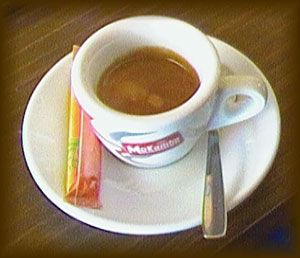


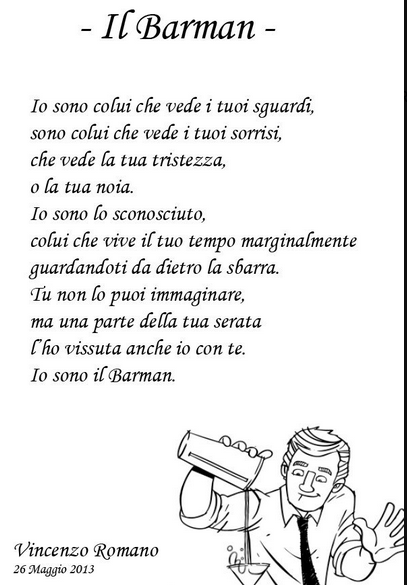

Comments powered by CComment